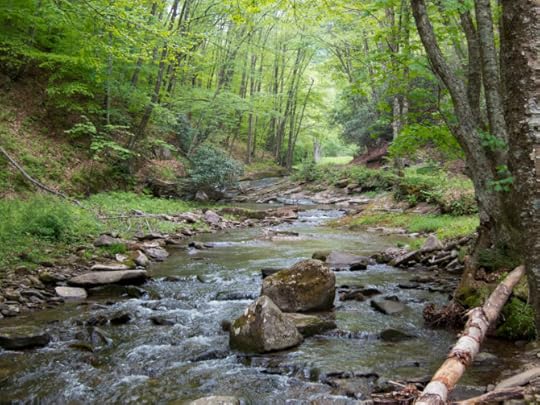Gear list: West Virginia & Appalachians in May
In mid-May I am returning to The Mountain State to guide an intro-level 3-day backpacking course in Spruce Knob-Seneca Rocks National Recreation Area, followed by a more advanced 5-day trip in Dolly Sods Wilderness. Rounding out the guide team will be Alan Dixon, Joseph “Stringbean” McConaughy, and Matthew Bright.
Seneca Creek and Dolly Sods are classic Appalachian environments: lush hardwood forests at lower elevations, thick guard spruce at the highest, occasional open meadows, rain and humidity, and seasonal ticks. My gear list for these locations is relevant to every other backcountry destination along the Appalachian corridor and throughout the Eastern woodlands.
Expected conditions
Gear selection should be driven primarily by:
Your trip objective; andThe environmental and route conditions.
For planning purposes, we assumed normal springtime conditions for this location. When an accurate short-term forecast becomes available, we will tweak our kits.
Temperatures. For the month of May, a nearby weather station at Canaan Valley (3200 feet) reports average high and low temperatures of 68 F and 42 F. The average elevation of our route is a little bit higher, so we’re expecting slightly cooler temperatures. Actual temperatures often swing +/- 10 degrees from these norms. Precipitation. The same weather station reports 6.1 inches of rain in May. Daylight. We’ll have ample daylight, since we’re just 6 weeks away from the longest day of the year. Civil twilight starts around 5:30 AM and ends at about 9 PM, giving us 14+ hours of daylight.Footing. The trails are a mix of dirt and rock, and can become wet and muddy. Dolly Sods, in particular, has legendary boot-sucking mud in its peat bogs. In Seneca Creek, the trails are more likely to just become slick.Vegetation. At the lower elevations, we’ll be shaded by a thick hardwood canopy. At high elevations, we’ll find guard spruce. The understory is not prohibitively dense. Both areas have open meadows with tall grasses and brush.Navigational aids. Trails are not blazed, but they are primitively signed. Visibility is usually limited, except when in the meadows. The topography ranges from flat to moderately sloped, and has few distinct features.Sun exposure. In Seneca Creek, the tree canopy blocks out most sunlight. The upper plateau in Dolly Sods has more open terrain, meaning more sun exposure on the occasional sunny day.Water availability. Topographic maps depict regular and perennial streams and springs, except atop ridgelines.Problematic wildlife. We found no reports of bear/human food conflicts. Rodents may be an issue at high-use campsites.Biting insects. Peak tick season starts once warm spring temperatures finally arrive. After walking through tall grass, tick-checks would be wise; permethrin-treated clothing would be a good precaution. Mosquitoes will be out but manageable.Remoteness. A road is never more than a few miles away, but this is a lightly inhabited area — cell service is spotty, and we’re several hours from the nearest medical facilities. These areas are popular with backpackers, but not as popular as destinations closer to the I-95 corridor like Shenandoah National Park.Natural hazards. In heavy rains, Seneca Creek and Red Creek can swell. Wandering off-trail in Dolly Sods should be done cautiously — unexploded ordinances from WWII training exercises are still occasionally found here.
 Seneca Creek
Seneca CreekBackpacking gear list: West Virginia in May
The applicability of this gear list goes well beyond 3-day trips in Seneca Creek. It could be replicated successfully for any springtime trip in the southern Appalachians (e.g. Appalachian Trail, Smokies, Blue Ridge, Shenandoah, etc.), possibly with small tweaks to comply with local regulations or conditions.
Summary
Here’s a big picture look:
The weight and cumulative cost are both on the high side:
These should be physically easy trips for me, and intentionally I’m packing luxuries like sleeping clothes, a bridge hammock, and a decent camera. I wouldn’t be surprised if my pack weighs more when I leave the trailhead — if it’s rainy, I’m going to bring an 8-oz umbrella and 1.5-lb group tarp; and for role-modeling purposes I may keep my food in an Ursack.Keep in mind that I get a lot of gear for free. If I had to pay for everything, I’d shop the sales and I’d seek out more economical substitutes.
Full list
To make this list more viewing-friendly, open it in new window.
If you like the look and organization of my gear list, consider using my 3-season gear list template.
Questions about my selections? Leave a comment.
Disclosure. I strive to offer field-tested and trustworthy information, insights, and advice. I have no financial affiliations with or interests in any brands or products, and I do not publish sponsored content
This website is supported by affiliate marketing, whereby for referral traffic I receive a small commission from select vendors like Amazon or REI, at no cost to the reader.
The post Gear list: West Virginia & Appalachians in May appeared first on Andrew Skurka.



